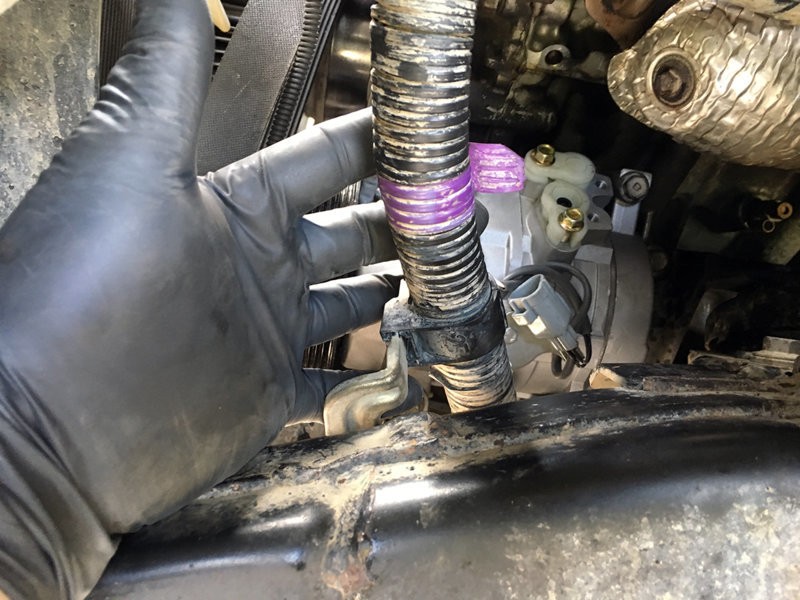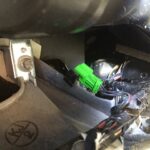Working on your car’s air conditioning system can seem daunting, but with the right guidance and tools, many tasks are manageable for the DIY enthusiast. When it comes to servicing your AC, one crucial step is safely draining the refrigerant from the system before carrying out repairs such as replacing the AC compressor or lines. For this, you’ll need specialized equipment, and Tool Rental For Draining Car Ac Lines is often the most cost-effective solution.
This guide will walk you through the process of accessing and disconnecting your car’s AC lines, similar to tasks required when replacing an AC compressor. While this article doesn’t explicitly detail refrigerant draining, it’s a critical preliminary step. Remember, safely handling refrigerant is paramount, and venting it into the atmosphere is illegal and harmful to the environment. Therefore, using the correct tools to recover the refrigerant is essential before you start disconnecting any lines. Renting tools ensures you have professional-grade equipment without the hefty purchase price.
Let’s look at accessing the AC lines, a step that often precedes the refrigerant draining process when component replacement is needed. In this example, we’ll refer to a Tundra model to illustrate the general steps involved.
First, you may need to move some components out of the way to get clear access to the AC lines. In many vehicles, a wiring harness can obstruct access to the AC compressor and its lines.
To move the battery wiring harness, locate its mounting point. In the Tundra, this harness is often secured to the inner driver’s side frame rail. Use a ratchet and a 12mm socket to loosen the bolt securing the harness.
Once loosened, you can remove the bolt completely. To prevent losing it amongst other bolts, especially those you’ll be removing from the AC compressor later, consider screwing it back in loosely for safekeeping nearby.
With the bolt removed, you can now maneuver the entire wiring loom. Moving it towards the front or firewall of the vehicle will provide you with better access to the AC compressor and its lines. This step can be a bit cumbersome, but creating space is crucial for the subsequent steps in AC service.
Now that you have better access, it’s time to locate and disconnect the AC lines from the compressor. Before proceeding, it’s absolutely critical to ensure the AC system has been properly and safely evacuated of refrigerant using appropriate recovery equipment. This is where tool rental for draining car AC lines becomes essential. You’ll need a manifold gauge set and a refrigerant recovery machine. These tools allow you to safely remove the refrigerant from the system before you open any lines, preventing environmental damage and potential injury.
Once you have confirmed the system is evacuated (pressure readings on your manifold gauges should indicate a vacuum), you can proceed to disconnect the AC lines. Typically, there are two lines connected to the AC compressor: the high-pressure line and the low-pressure line.
Identify the lines. Usually, the high-pressure line is slightly smaller in diameter than the low-pressure line. You’ll need a ratchet and a 10mm socket to remove the bolts securing these lines to the compressor.
It’s generally recommended to remove the low-pressure line first. Even after evacuation, there might be a small amount of residual pressure in the system, so be prepared for a slight pop sound as you loosen the line.
Immediately after disconnecting each line, it’s crucial to prevent debris and moisture from entering the open lines and compressor ports. A simple and effective method is to twist a piece of paper towel and insert it into the openings.
Next, move on to disconnecting the high-pressure line. You might need to use a longer extension with your ratchet and 10mm socket for better access depending on your vehicle model. Again, be prepared for a potential slight pop as you disconnect the line, and promptly seal the opening.
After removing the high-pressure line, you’ll often encounter a high-pressure adapter elbow. This component also needs to be removed for compressor replacement.
This adapter elbow is typically secured with smaller bolts. You will need a smaller socket for these, often a 5.5mm or a 7/32″ socket. Ensure you have the correct size for a snug fit to avoid stripping the bolt heads.
With the AC lines and adapter removed, now is an excellent time to replace the O-rings or seals on the lines and adapter. Using needle-nose pliers, carefully remove the old O-rings, being cautious not to scratch the fittings.
When installing new O-rings, ensure you are using the correct size and type, often included in AC system seal kits. Replace them one at a time to avoid mixing up sizes. Lubricating the new O-rings with refrigerant oil before installation can help ensure a good seal.
In conclusion, while this guide illustrates the steps to access and disconnect AC lines, remember that safely draining the refrigerant is the first and most critical step. Tool rental for draining car AC lines provides access to the necessary professional equipment like manifold gauge sets and refrigerant recovery machines, making DIY AC service safer, environmentally responsible, and more affordable. Always prioritize safety and environmental regulations when working with automotive AC systems.



